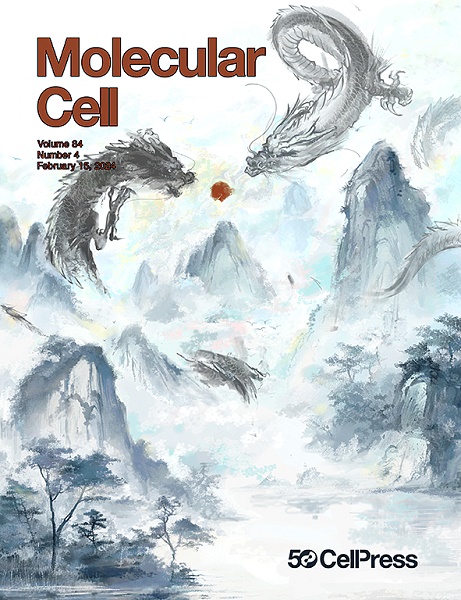IF 14.5
1区 生物学
Q1 BIOCHEMISTRY & MOLECULAR BIOLOGY
引用次数: 0
摘要
RNA 的催化、调节或编码潜力取决于结构的形成。由于碱基配对发生在转录过程中,因此早期的结构状态可以控制 RNA 处理过程,并决定功能构象的形成。这些共转录状态大多仍不为人所知。在这里,我们开发了共转录结构跟踪(CoSTseq)技术,它能检测活酵母细胞中 RNA 聚合酶(Pols)转录组宽内和转录组宽退出时的新生 RNA 碱基配对。通过监测转录过程中每个核苷酸的碱基配对活动,CoSTseq 发现了主要的快速配对--在转录加入新生链后的 25 bp 内。此外,23% 的 rRNA 核苷酸在 Pol I 附近达到最终碱基配对状态,而其他大多数核苷酸必须在核糖体生物发生的后期步骤中改变配对状态。我们的研究表明,螺旋酶会立即发挥作用,重塑整个 rDNA 位点的结构,以促进核糖体的生物发生。相比之下,新生的前mRNA获得的局部结构与成熟的mRNA无异,这表明在伸长的核糖体后面的折叠类似于在Pol II后面的共转录折叠。本文章由计算机程序翻译,如有差异,请以英文原文为准。

Rapid folding of nascent RNA regulates eukaryotic RNA biogenesis
RNA’s catalytic, regulatory, or coding potential depends on structure formation. Because base pairing occurs during transcription, early structural states can govern RNA processing events and dictate the formation of functional conformations. These co-transcriptional states remain mostly unknown. Here, we develop co-transcriptional structure tracking (CoSTseq), which detects nascent RNA base pairing within and upon exit from RNA polymerases (Pols) transcriptome wide in living yeast cells. Monitoring each nucleotide’s base pairing activity during transcription, CoSTseq reveals predominantly rapid pairing—within 25 bp of transcription after addition to the nascent chain. Moreover, ∼23% of rRNA nucleotides attain their final base pairing state near Pol I, while most other nucleotides must undergo changes in pairing status during later steps of ribosome biogenesis. We show that helicases act immediately to remodel structures across the rDNA locus to facilitate ribosome biogenesis. By contrast, nascent pre-mRNAs attain local structures indistinguishable from mature mRNAs, suggesting that refolding behind elongating ribosomes resembles co-transcriptional folding behind Pol II.
求助全文
通过发布文献求助,成功后即可免费获取论文全文。
去求助
来源期刊

Molecular Cell
生物-生化与分子生物学
CiteScore
26.00
自引率
3.80%
发文量
389
审稿时长
1 months
期刊介绍:
Molecular Cell is a companion to Cell, the leading journal of biology and the highest-impact journal in the world. Launched in December 1997 and published monthly. Molecular Cell is dedicated to publishing cutting-edge research in molecular biology, focusing on fundamental cellular processes. The journal encompasses a wide range of topics, including DNA replication, recombination, and repair; Chromatin biology and genome organization; Transcription; RNA processing and decay; Non-coding RNA function; Translation; Protein folding, modification, and quality control; Signal transduction pathways; Cell cycle and checkpoints; Cell death; Autophagy; Metabolism.
 求助内容:
求助内容: 应助结果提醒方式:
应助结果提醒方式:


